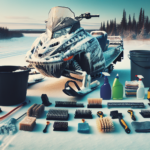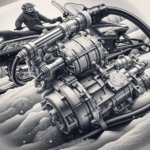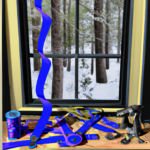You’ve just finished an adventurous ride on your snowmobile, cutting through the snowy landscapes like a champ. But as thrilling as that ride was, it’s now time to pay attention to the aftermath – the cleaning of your snowmobile. You might consider it a daunting task, but to ensure effective performance and longevity of your prized snowmobile, regular cleaning is inevitable. This article will guide you through the step-by-step process of giving your snowmobile a thorough clean-up, thus keeping it sleek and pristine, always ready for your next winter expedition. So, gear up and get ready to add another skill to your snowmobiling expertise!
Understanding Snowmobile Components
Snowmobiles are complex machines, with different parts each serving their specific purpose. Understanding these various components will enable you to maintain your snowmobile’s optimum performance and extend its lifespan.
Identifying Different Parts of the Snowmobile
Like any transportation machine, a snowmobile has many parts, and knowing what they are and how they function can make cleaning and maintaining your snowmobile easier and more effective. Key parts include the engine, track, skis, windshield, and seat.
How Snow and Ice Affect Different Components
Ever wondered how snow and ice can affect your snowmobile? Over time, accumulated snow and frost can freeze and add pressure on various parts of your snowmobile – most notably your track and skis, and potentially lead to mechanical issues. Certain parts of the engine can rust when exposed to water continuously, which may cause damage or a loss in efficiency.
Essential Parts to Clean Regularly
Just like a car, certain components of a snowmobile must be cleaned regularly. This includes the windshield, for visibility purposes; the exhaust ports, to prevent carbon build-up; and the skis for overall smooth operation. By keeping these parts clean, you can improve your ride quality and ensure the longevity of your snowmobile.
Gathering Cleaning Tools and Materials
Cleaning a snowmobile requires the right tools and materials. Whether they are common household items or specific cleaning products, preparedness can make the job more efficient and trouble-free.
Common Household Items that Can Be Used
You’d be surprised what else around the house you can use when it’s time to clean your snowmobile. Simple items like a bucket, clean clothes, and a standard garden hose can step up to the job. Use an old toothbrush to clean tight spaces and a paintbrush can dust off hard-to-reach areas.
Cleaning Products Safe for the Snowmobile
Snowmobiles are constructed from combination of materials including metal, rubber, and plastic, each requiring its own type of care. It’s important to make sure you’re using non-abrasive cleaning solutions that won’t damage your snowmobile.
Investing in Specialized Snowmobile Cleaning Tools
You can also consider investing in some specialized snowmobile cleaning tools. These tools have been specifically designed for cleaning snowmobiles and can dramatically improve your results. For example, a snowmobile brush can make it easier to clean the track and skis, while a dedicated cleaner for the engine can help reduce build-up.
Preparation for Cleaning
Before reaching for your cleaning tools, some preparations should be done first. Take note of safety protocols, the right cleaning techniques and make sure that your work area is ready.
Setting Up Your Work Area
Your chosen work area needs to be large enough for the snowmobile and for you to get around it comfortably. Ensure it’s well-lit and ventilated, and make sure you have the necessary tools and cleaning products within reach when you need them.
Safely Removing Key Components Before Cleaning
If you feel confident enough, you might want to consider removing certain components of your snowmobile such as the seats, windshield, and skis for a thorough cleaning. Make sure to keep track of screws, bolts, and other small parts.
Properly Turning Off the Snowmobile
Safety comes first when you’re preparing to clean your snowmobile. It’s crucial to make sure the snowmobile is turned off and cooled down before you begin cleaning. This will protect you from burns and other injuries that could result from handling hot engine parts or getting wet around electrical parts.
Cleaning Exterior of the Snowmobile
Cleaning the exterior of your snowmobile not only keeps it looking good but also enables you to spot any potential issues such as cracks, rust, or loose parts.
Using Gentle Soap and Water Solution
A gentle soap and water solution is usually enough for most of the snowmobile’s body. Use a soft cloth to apply the solution, gently scrubbing away any dirt, mud, or road grime.
Being Careful with Paint and Chrome
Unfortunately, paint and chrome parts on snowmobiles can be easily scratched or dulled if you use the wrong cleaning methods. Use a soft, non-abrasive cloth and gentle detergent to avoid damage.
Rinsing and Drying Techniques
After washing your snowmobile, make sure you rinse every part thoroughly to ensure no soap or cleaning product residue is left. Following rinsing, use microfiber cloths to dry the snowmobile. Leave it to air dry for a while, assuring every little bit of moisture has evaporated before further steps.
Cleaning Snowmobile Engine
When it comes to cleaning the snowmobile engine, it’s all about caution. The engine contains delicate parts that must be handled with care.
Preventing Water Damage
Keep in mind that electronics and water do not mix. To prevent water damage, don’t spray water directly towards any parts that house electrical systems or connections.
Cleaning the Engine Bay
For cleaning the snowmobile’s engine bay, use a special cleaner that is designed for engine parts. This helps in removing oil, grime, and other debris that could reduce engine performance.
Making Sure All Parts are Dry Before Re-installation
Before you put back any parts that were removed during cleaning, make sure each one is completely dry. This prevents unnecessary dampness in the engine bay, which could lead to corrosion.
Cleaning Interior and Undercarriage
The undercarriage and interior areas of your snowmobile are important parts that need cleaning too. A proper cleaning can ensure optimal operation of these components.
Using Special Brushes for Hard to Reach Areas
To clean those hard-to-reach places, use a long-handled brush or a pressure washer. But, as always, be gentle and make sure not to force water into sensitive components.
Cleaning Skis and Track
The skis and track are the areas most exposed to snow, ice and salt, and therefore require special attention. Use a gentle brush to sweep away any stuck snow or ice, and then apply a mild detergent and rinse thoroughly.
Checking for Damage or Wear During Cleaning
Cleaning can also be an opportunity to carefully inspect your snowmobile for signs of damage or wear. These could come in the form of cracks, worn-out components, rusting or loose elements. Catching these problems early on could mean less costly repairs.
Cleaning Snowmobile Seat and Windshield
The snowmobile seat and windshield are easily overlooked but cleaning them helps improve your overall riding experience.
Finding Suitable Cleaning Products
You need to find a suitable cleaning product that won’t damage the material of your snowmobile’s seat and windshield. Avoid products containing harsh chemicals since they may cause these parts to lose resistance or turn brittle.
Avoiding Scratching the Windshield
Your snowmobile windshield can scratch easily, affecting visibility over time. Try to use a soft cloth during cleaning, and use smooth, circular motions to avoid leaving scratches.
Maintaining Seat’s Comfort and Appearance
Cleaning the snowmobile seat isn’t just about making it look good – it also contributes to your comfort. Clean the seat using mild soap and water, and consider using a protecting spray to prevent fading or cracking.
Post-Cleaning Maintenance
After cleaning your snowmobile, some additional tips can help you maintain its good condition for much longer.
Lubricating Moving Parts
Moving parts like your suspension and drivetrain need lubricating after cleaning. This ensures smooth operation and prevents unnecessary wear and tear.
Checking for Any Operational Issues
Once your snowmobile is cleaned and dried, fire up the engine and check if there are any unusual noises, any poor performance, or other signs that something might be wrong.
Storing Snowmobile Properly After Cleaning
Cleanliness alone won’t preserve your snowmobile in a good condition. You need to store it properly to prevent it from being damaged while not in use.
Knowledge of Cleaning a Snowmobile in Different Seasons
Cleaning your snowmobile can vary slightly depending on the season. The technique and products you use might be a little different during the warmer months compared to the colder months.
Changes in Cleaning Method Depending on Temperature
During summer months, when the temperatures can get relatively high, you need to ensure that you clean your snowmobile in a shaded area to prevent cleaning soap from drying out on the snowmobile and causing streaks. In colder months, be careful to ensure that all the parts of the snowmobile are dry before storing it, to prevent freezing inside the engine.
Preparation for Long-Term Storage
If you plan to put your snowmobile in storage for a long period of time, there are specific steps you’ll need to take to protect it. Remember to store it in a dry, cool place, cover it with protective clothing and make sure all movable parts are lubricated.
Pre-Ride Optional Cleaning Habits
Adopting pre-ride cleaning habits can also help make your snowmobile maintain top working condition. Wipe down your snowmobile and check for any damage or issues prior to each ride.
Snowmobile Cleaning FAQs
Here are some frequently asked questions most snowmobile owners have when it comes to cleaning.
Frequency of Cleaning
One of the most common inquiries is how often should a snowmobile be cleaned? A good recommendation is to clean your snowmobile after every ride to maintain peak performance and longevity.
Common Mistakes to Avoid
Remember to never rush the cleaning process. Skipping cleaning steps or areas might lead to damage on those parts later on due to accumulated corrosion. Using harmful detergents, and not properly drying the snowmobile after cleaning is also something to avoid.
Useful Tips to Enhance the Cleaning Experience
To have a smoother and more efficient cleaning experience, always have your cleaning tools and products nearby before starting. Know which parts of your snowmobile need which type of cleaners to avoid damage. Also, keep a routine. This way, it will become part of your regular snowmobiling habit. This will keep your machine looking pristine all season long.
- What Snowboard Bindings Should I Get? - January 23, 2024
- What Size Screws For Snowboard Bindings? - January 23, 2024
- How To Snowmobile On Water? - January 23, 2024








